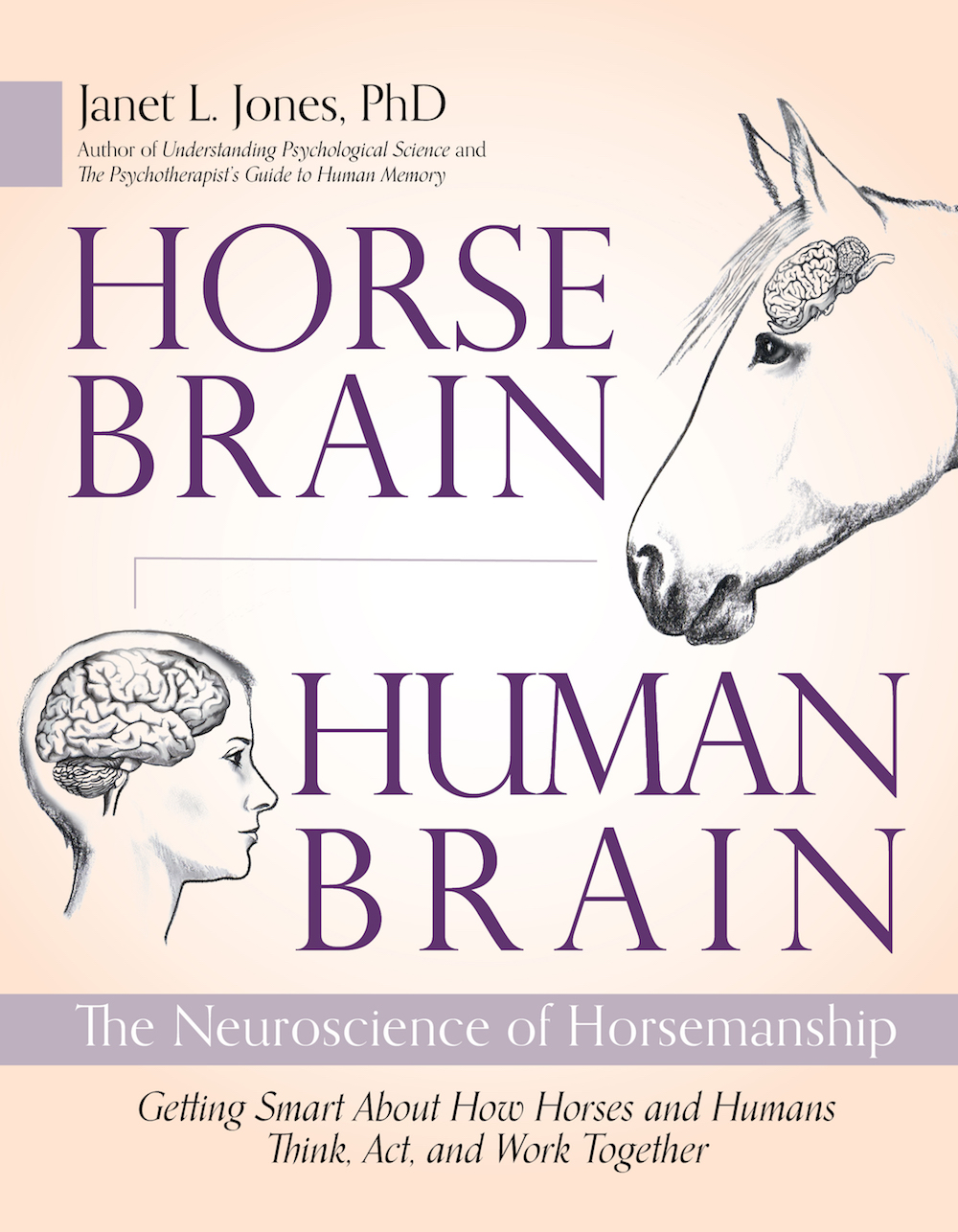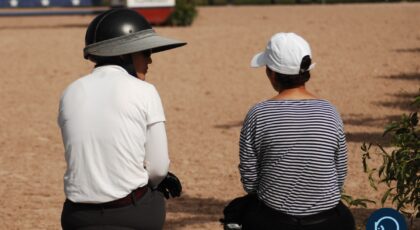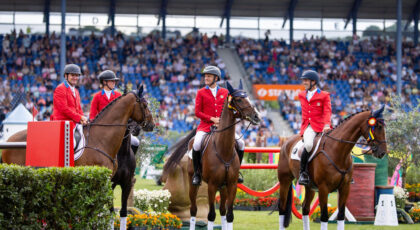First, to follow up from True’s recent injury, he is much better.
All the swelling is gone, no further sign of infection, and the two open wounds are clean and healing. He can carry me at a walk, trot, and canter comfortably, with no pain. Thank you for your positive thoughts. We’re good! So…
Today’s article marks one hundred entries about True’s training! It feels like only a moment has passed since “Baby True” came into my life. What a wonderful companion he has been.
Let’s do a little comparison: then and now.
True came to me having just turned three, with a mouthful of baby teeth and a weight of about 1,250 pounds. He stood 16.1 or 16.2 hands high. His head was too big for his neck, his croup surpassed his withers, he had spindly legs, enormous feet, and a hay belly. He had excellent jumping bloodlines and conformation genetics, but you wouldn’t have known it at first glance.
Well, he’s fully grown now and still has the enormous feet; sometimes I call him Sasquatch (Sassy for short) because of those feet. They are classic round feet that are very strong. True has been barefoot for all but one six-week period of his life. Most of my horses in the past have needed shoes due to thin walls or soles. Not True!
He weighs 1,500 pounds today and stands 17.1 hands high, barefoot. By the way, at least one inch of that height, maybe two, appeared during his seventh year—much later than most people would expect.
All of True’s sweet baby teeth are gone; he has a mouthful of adult chompers now. He lives on the highest quality hay and fresh grass I can find, so he has no need for supplements. His coat is thick and shiny, and he attracts attention for his excellent conformation. The croup and withers finally evened out, his neck grew into the size of his head, and the hay belly disappeared.
For most of his life, Trouper has lived in a large pasture with multiple horses 24/7. Nowadays, he is brought in at night, but to an enormous indoor stall (nearly 25 feet square) connected to an even larger outdoor run. The barn is open and airy for excellent ventilation and nice cool horse temperatures. He has about 30 equine buddies on a 70-acre ranch and knows all the people. Not a bad life for a horse!
For those of you who remember True’s very first lesson, I’m happy to report that he catches very well. In a dry paddock, he comes to me immediately when I call.
His performance is slightly undermined when he’s in a 30-acre pasture full of rich green grass and a dozen playmates. Sometimes he comes to me from that location, sometimes he doesn’t. But he never evades me.
True is easy to groom and tack up. Only once in his life did he go through a head-shy phase—and that was clearly due to temporary mishandling by turnout staff with poor skills. Even then, he would approach me immediately; it was just the haltering or bridling that he disliked. I re-trained for about a month, and he was fine. His bridle’s in better shape now—True doesn’t chew on the reins any more.
True Blue has learned almost all of his lessons—ground manners, round pen, groundwork, longeing, under saddle, flat and over small fences, Western/English/bareback, trail gates and bridges, trailering—through training by reward, usually non-edible reward. He has flourished with this approach, which is based on current neuroscience about the release of dopamine. He seeks to behave in ways that earn non-edible rewards and demonstrates the internal motivation and enjoyment in performance that this training technique creates.
The young colt who was scared of the barn aisle now stands tied in one, completely quiet and patient. Now and then, a horse gets loose in the aisle, and True raises his head in interest but stands firm.
He can be vacuumed, clipped, fully groomed. He lifts his feet politely for his farrier and approaches unafraid for his veterinarian. When horses run with excitement outside of the barn, he watches but remains in position.
He knows not to urinate in the barn aisle, under saddle, or in the wash rack. He passes mares politely in the arena, but still cocks one little corner of the ear nearest them just to show his approval. His 90-degree spins away from killer birds still occur, but only rarely and much, much slower. And, as you’ve seen in previous articles, True is very brave with snakes.
Little Mr. Clumsy can now walk, trot, and canter in a long round frame, using his hindquarters well and responding to all my aids without the need for spurs. He travels with a long extended neck, softly arched, ears only slightly above his withers, with his face approaching—but not quite reaching—the vertical. It’s a very natural headset for a rounded horse who moves through his hindquarters.
I don’t use tight, flash, dropped, crank, or figure-8 nosebands on any of my personal or training horses—good hands and good schooling preclude all that needless equine pain and confinement. His mouth remains soft and closed with a loose simple cavesson noseband and an eggbutt snaffle. In western tack, he wears no noseband at all and the same eggbutt snaffle. There’s no need to “progress” to a harsh bit when a soft one will do.
True’s circles are perfectly round, he can do shoulder-ins and leg yields at various gaits, he never misses a lead. He backs up readily most of the time, but every now and then we still have some resistance to overcome on that. He pivots back and forth 180 degrees at a walk or trot along the rail, makes turns on the haunches and forehand, completes figure eights at all gaits forward and backward, does daily serpentines, negotiates all manner of cavaletti or ground poles, hops easy gymnastics, and trots or canters over low jumps of all varieties.
He would be farther along in jumping by now if it weren’t for varied problems with arena footing and rider injuries. And he is perhaps the only son of Imothep and grandson of Indoctro (both Olympic jumpers) who can sort calves.
True is sociable, like he was as a baby—loves people, wants attention, perpetually curious. Before he is turned out to pasture every morning, he waits for people to walk down the barn aisle. Just as they get to his area of the barn, he snatches his halter off the hook next to his stall door and throws it out into the center of the aisle at their feet. He’s got good aim!
Then he stares at them, as if to say, “there’s the halter, take me out please.”
Truedini can still open most any gate latch and untie himself with ease. Usually when he unties himself, he remains in place afterward.
True and I are bonded deeply. He knows that I am his guide, I will take care of him, protect him from human dangers, and meet his needs. When something is wrong, he gets my attention right away and shows me what it is.
One day he injured a lower leg, gimped around on it until I arrived at his stall, then immediately approached me and held the leg up in the air for me to see. Only a rock would have missed his message. True is comfortable and relaxed in my presence, attentive but not worried or concerned unless there is something in the environment that warrants his concern.
I feel very lucky to have True in my life, and I try to let him know every day how much I appreciate him. Could his training progress more quickly? Yes. But then it wouldn’t be so deep.
And in brain-based horsemanship, deep bonds are much more important. I’m not in a hurry. As you can see, I’m proud of True and happy with the results of my training. We both have much more to learn and are eager to continue the process.
Related reading: Read the full library of Janet Jones, PhD, brain-based training journey with True.
Brain-Based Horsemanship is a weekly column that chronicles Janet Jones, PhD, and her journey with True, a Dutch Warmblood she trained from age three using neuroscience best practices. Read more about brain-based training in Jones’ award winning book Horse Brain, Human Brain.

A version of this story originally appeared on janet-jones.com. It is reprinted here with permission.


 February 13, 2025
February 13, 2025 

























